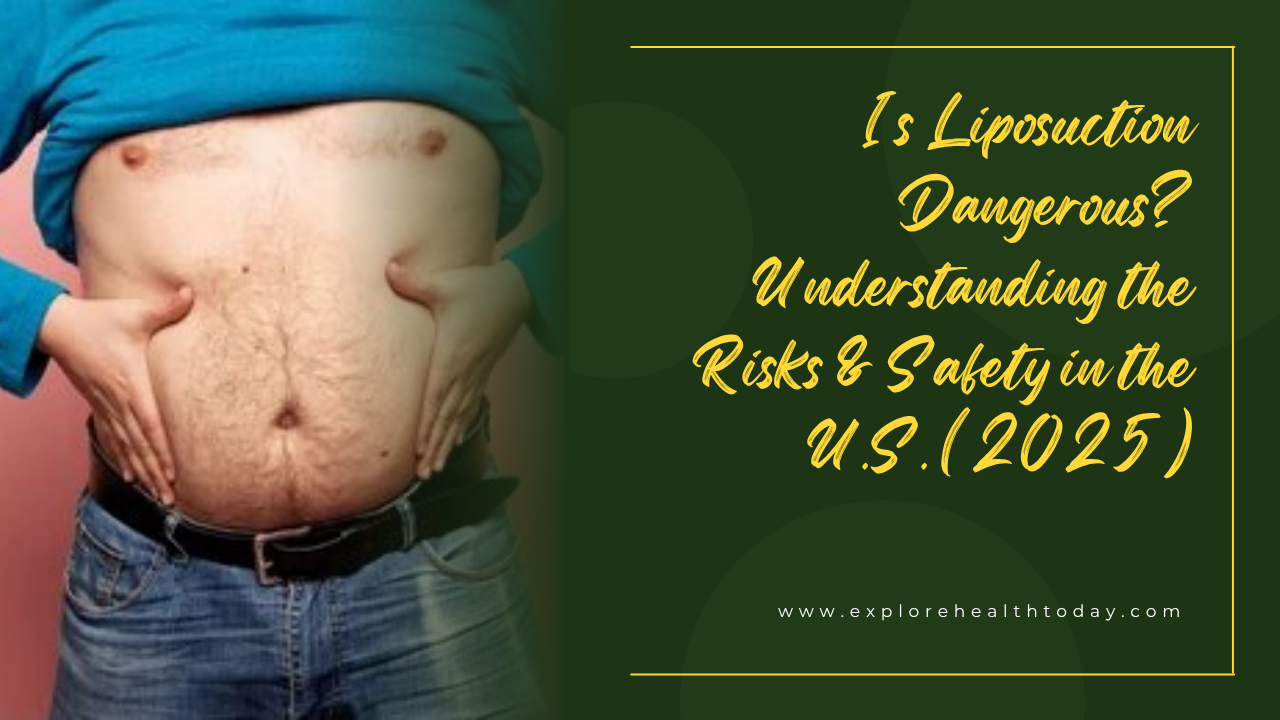Introduction
Liposuction is the most popular cosmetic procedure in the U.S., with over 350,000 procedures performed in 2023—marking a 30% rise since 2019. But amid this surge, many Americans wonder: Is liposuction dangerous? This blog explores the benefits, realistic risks, key safety measures, and how to decide with confidence.
Understanding Liposuction Basics
Liposuction (or “lipo”) removes stubborn fat from areas like the abdomen, thighs, arms, and neck . It isn’t a weight-loss method but a body-contouring tool. Results depend on skin elasticity and overall health.
What Are the Risks?
Common Side Effects
- Bruising & swelling: Can last several weeks
- Temporary numbness or changes in sensation—called paresthesia
- Contouring issues: Skin irregularities or rippling
Serious & Rare Complications
- Fat embolism—potentially fatal when fat enters bloodstream
- Deep vein thrombosis (DVT) or pulmonary embolism
- Organ perforation, bleeding, infection—rare but serious
- Anesthesia risks & lidocaine toxicity
Mortality Data
- Liposuction accounts for nearly 44% of cosmetic surgery deaths in some regions
- Overall fatality rates: 1 in 10,000 cases
- CDC data (2019–2022) links fat embolism to most U.S. cosmetic surgery deaths
Why It’s Riskier in Certain Settings
Some high-volume clinics, especially in states like Florida and California, have reported higher complication rates due to rushed procedures and cost-cutting shortcuts. Risks also increase when liposuction is combined with other surgeries—especially the Brazilian Butt Lift (BBL). Non-certified providers and budget clinics often bypass essential safety protocols.
Safety First—Choosing the Right Path
Choose a board-certified surgeon
Always ensure your surgeon is certified by the American Board of Plastic Surgery and not just a “cosmetic surgeon.” Certification ensures your provider meets rigorous training, ethics, and patient care standards.
Verify facility accreditation
Your surgery should take place in an accredited facility—look for certifications from AAAASF, ASC, or JCAHO. These centers follow safety protocols and have emergency preparedness in place.
Follow evidence-based techniques
The American Society of Plastic Surgeons recommends procedures be performed in stages to limit anesthesia time. Tumescent liposuction remains the safest and most effective method, reducing the risk of bleeding and lidocaine overdose.
Take post-operative care seriously
Proper post-op care includes:
- Wearing compression garments
- Avoiding smoking and alcohol
- Light activity to promote blood flow
- Following all prescribed medications and instructions
U.S. Trends (2024–2025)
Liposuction has gained even more popularity due to body changes after weight-loss drugs like Ozempic and Wegovy. Gen X (ages 40–54) currently leads the demographic demand. The American aesthetic industry projects continued growth through 2025, with liposuction retaining its #1 spot for surgical procedures.
Alternative & Complementary Options
For those looking for less invasive solutions, non-surgical body contouring methods like CoolSculpting, SculpSure, and ultrasound therapy offer fat reduction without surgery. Although results are more subtle and take longer, the risks are considerably lower.
Surgical alternatives for specific conditions, such as lipedema, are also becoming more standardized and insurance-friendly in some U.S. states, according to Louisiana Department of Health research.
Frequently Asked Questions (FAQs)
Is liposuction dangerous?
Yes, it carries risks like any surgery. However, when performed by certified professionals in accredited settings, the risks are minimal and largely preventable.
Can I combine it with other procedures?
It’s technically possible but not always safe. Staged procedures are safer and recommended for multiple treatment goals.
How do I reduce the risk of complications?
Work only with board-certified plastic surgeons, ensure the surgical facility is accredited, undergo proper medical screening, and follow all pre- and post-operative guidelines closely.
Conclusion
So, is liposuction dangerous? Like any surgical procedure, it carries risks—some serious. However, with proper training, credentials, facilities, and evidence-based practices, complication rates are low and mostly manageable. For those seeking body contouring, liposuction remains a viable, effective option—but informed decisions and patient safety always come first.
If you’re considering liposuction, consult a board-certified plastic surgeon and have an in-depth safety discussion. Knowing “is liposuction dangerous” helps you make a confident, well-informed choice about your body—and your health.
About ExploreHealthToday.com
ExploreHealthToday.com was created to be a one-stop resource where readers can find up-to-date, well-researched articles on a variety of health topics. From nutrition and wellness to lifestyle and mental health, we strive to provide reliable information to help you make informed decisions about your well-being.
We believe that good health starts with good information, and our mission is to empower our readers with knowledge they can trust.
Visit us at ExploreHealthToday.com to learn more.





